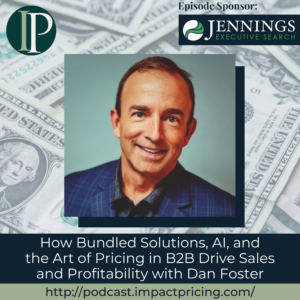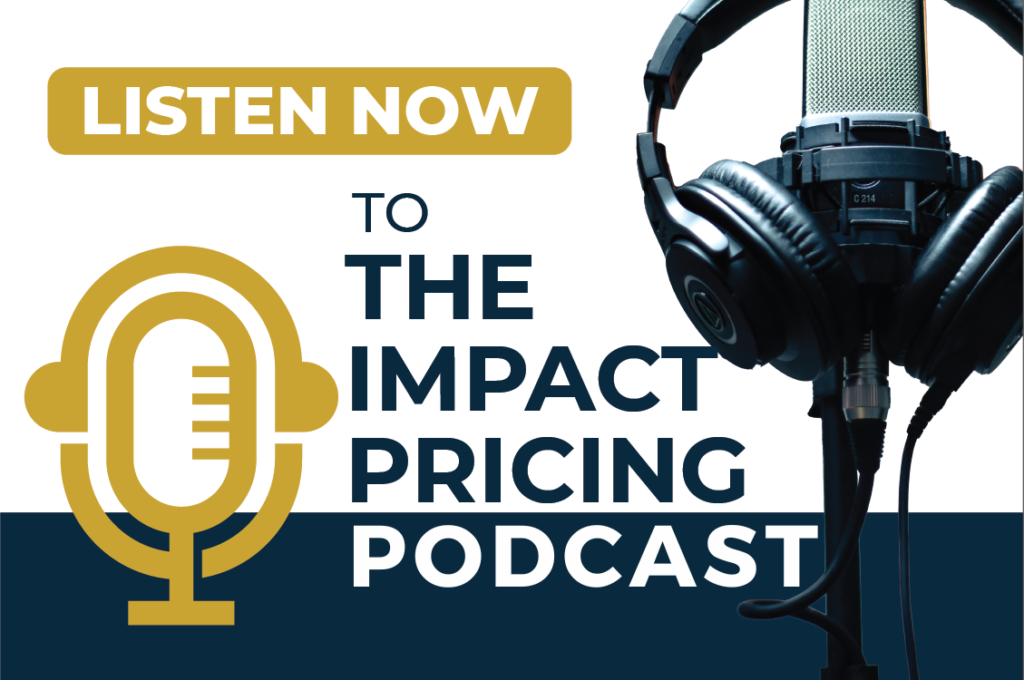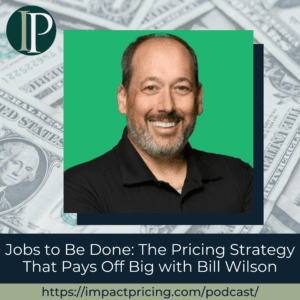Dan Foster is a Chief Operating/Revenue Officer, who built and transformed profitable businesses across technology and telecom start-ups as well as industry powerhouses. Companies turn to him to revive struggling businesses by redefining sales, marketing and customer service strategy, scaling infrastructure, and promoting product innovation.
In this episode, Dan shares how bundled solutions increase value and close rates. He discusses AI’s growing role in B2B sales and procurement. And stresses using data to understand customer needs and justify pricing.
Podcast: Play in new window | Download
Why you have to check out today’s podcast:
- Learn how bundling products and services can enhance perceived value, increase close rates, and prevent price-sensitive buyers from deconstructing your offerings.
- Gain insights into how AI is transforming the sales landscape, from optimizing product recommendations to procurement teams using AI to negotiate better prices.
- Understand why pricing should be tied to the customer’s business outcomes and how to communicate the true value of your solutions effectively.
“You take the data around a pricing example and you really understand the value from the end user’s perspective, so you got to have that empathy back in to say what moves their business. And when we understand what moves their business with a few numbers, then you start to give the underpinning for why value pricing matters.”
– Dan Foster
Topics Covered:
02:01 – How his early consulting work made him think about value and led him to pricing
03:23 – Asking about typical reactions to pricing presentations
04:24 – Explaining that selling value starts with understanding product-market fit
07:03 – Highlighting the importance of teaching distribution partners how to sell value, using the Home Depot-SolarCity partnership as an example
10:43 – How can ROI calculators be convincing
14:07 – Explaining that while they don’t track proven value directly due to lack of data, anecdotal feedback and supplier insights indicate improved close rates for partners
15:09 – How AI is reshaping product offerings, expanding technology advisors’ roles, and influencing cost-cutting for innovation
19:10 – Highlighting that while AI may drive procurement efficiencies complex digital transformation solutions still rely on expertise
20:27 – How bundling simplifies purchasing and reinforce the value of an all-in-one solution
24:27 – Dan’s best pricing advice
Key Takeaways:
“If you want to buy a ton of storage and it’s a commodity, we get that. That could go through the marketplace earlier than not. If you want a digital transformation, if you want to change your customer experience, if you want to make your business run faster, if you want business process automation and robotic process automation, that’s not going through a dynamic pricing model on a marketplace near-term. Now, can I go out and look at, like, UiPath Licensing versus Automation Anywhere versus whoever Microsoft scooped up next and look at pricing models? The procurement folks are probably smart to do that.” – Dan Foster
“But the bundled solution specifically is, I think, fundamental because otherwise, when you offer them the menu-based pricing, oftentimes they don’t see the full value.” – Dan Foster
“It [selling value] starts with that product-market fit. We do a lot of enablement of our partners or downstream almost like a two-tier distributor. And in doing that we provide the ability for them to see a higher close rate when they use tools and resources. It alleviates that conversation and it’s inherent that there’s value pricing there.” – Dan Foster
“It’s critical to think through in a subscription-based model what that value is, because that customer acquisition cost versus the long-term value of a customer, it’s a critical ratio to understand when you’re thinking through pricing.” – Dan Foster
People/Resources Mentioned:
- Cummins Engine Company: https://www.cumminsenginepart.com/
- Unilever: https://www.unilever.com
- Alcoa: https://www.alcoa.com/global/en/home/
- Amazon: https://www.amazon.com/Selling-Value-Deals-Higher-Prices/product-reviews/1737655217/ref=cm_cr_dp_d_show_all_btm?ie=UTF8&reviewerType=all_reviews&
- SolarCity: https://en.wikipedia.org/wiki/SolarCity
- Home Depot: https://www.homedepot.com
- Azure: https://azure.microsoft.com/
- Google: https://www.google.com/?client=safari
- Lowe’s: https://www.lowes.com
- Sun Power: https://us.sunpower.com
- Sunrun: https://www.sunrun.com
- TD Synnex: https://www.tdsynnex.com/na/us/
- Ingram Micro: https://www.ingrammicro.com
- Five9: https://www.five9.com
- Genesys: https://www.genesys.com/en-sg/
- NICE inContact: https://www.nice.com/
- Zoom: https://zoom.us
- Dialpad: incontact.com/content/home.htm
- ChatGPT: https://chatgpt.com
- Wall Street Journal: https://www.wsj.com/
- Automation Anywhere: https://www.automationanywhere.com
- Microsoft: https://www.microsoft.com/en-ph/
- UiPath Licensing: https://licensing.uipath.com/
- Hulu: https://www.hulu.com/welcome?orig_referrer=https%3A%2F%2Fwww.google.com%2F
- Roku TV: https://www.roku.com/products/roku-tv?srsltid=AfmBOoomwWI9G8ZABYW7gSPFzBHc87xVmartPBXAWzj7GfPfAJQYjTtO
- Super Bowl: https://en.wikipedia.org/wiki/Super_Bowl
- Xfinity: https://www.xfinity.com/
Connect with Dan Foster:
- LinkedIn: https://www.linkedin.com/in/jdanfoster/
- Email: [email protected]
Connect with Mark Stiving:
- LinkedIn: https://www.linkedin.com/in/stiving/
- Email: [email protected]
Full Interview Transcript
(Note: This transcript was created with an AI transcription service. Please forgive any transcription or grammatical errors. We probably sounded better in real life.)
Dan Foster
You take the data around a pricing example and you really understand the value from the end user’s perspective, so you got to have that empathy back in to say what moves their business. And when we understand what moves their business with a few numbers, then you start to give the underpinning for why value pricing matters.
[Intro / Ad]
Mark Stiving
Welcome to Impact Pricing, the podcast where we discuss pricing, value, and the undeniable relationship between them. I’m Mark Stiving and I run boot camps to help companies get paid more. Our guest today is Mr. Dan Foster. Here are three things you want to know about Dan before we start. He is the Chief Revenue Officer at Telarus. He was head of global sales and wireless office for Ericsson. As you run through his whole LinkedIn background, my favorite job he had was, he was a VP of Sales for SolarCity at one point in time. And he is the co-founder of Trek for Autism. Did that seven years ago and is still part of that organization. Welcome, Dan.
Dan Foster
Thanks, Mark. Great to talk to you.
Mark Stiving
It’s going to be fun. So I always start with the question, how did you get into pricing? So I’m just going to ask it even though I know you’re not in pricing. How did you get into pricing?
Dan Foster
Well, I started early. I was in consulting and when you’re writing proposals to Cummins Engine Company or Unilever, you’re starting to understand what’s the value that they get out of the work that you’re doing. And so it inherently gets you to pricing, I guess. But so I guess I’ve always been part of it, Mark, I really never thought of it that way. It’s always been integral to this kind of job.
Mark Stiving
Okay. So I’m shocked by what you just said, if you want to know the truth, right? So you’re a young kid, you’re in consulting and you’re thinking about value. We have salespeople nowadays that are 40, 50 years old and have no idea what value means.
Dan Foster
Yeah. Well, I guess it was, I don’t know, maybe I can credit an economics professor with value, quality, price kind of ratios or something like that. But I probably didn’t inherently do that, but it was like, hey, in fact, it was my first experience that I think I radically underpriced the proposal when he said, ‘Oh yeah, we’re ready.’ I was like, ‘Wait, just like that?’ And I was talking to the CEO of a division of Alcoa. Alcoa bought Alcoa, the aluminum guys. And I remember his name to this day, Chuck. And I was like, boy, I got off the phone. I was like, I might have underpriced that thing.
Mark Stiving
So I think anytime someone says yes immediately you know that happened.
Dan Foster
Yeah. That’s kind of, I guess my question to you would be, what is that kind of visceral or cerebral or even facial reaction in this day and age of video that we should expect when presenting pricing?
Mark Stiving
Oh, that’s a great question. I don’t know what you should expect, but what I think it should be is first we have a value conversation so that somebody understands what’s the value of what it is we’re delivering to the customer. And then the price just falls into place, right? Oh, I’m going to make you a million dollars, a hundred thousand is nothing.
Dan Foster
Right. Yeah. True leverage. Yeah.
Mark Stiving
Yeah. So I’m not sure that we would present it without having seen the value.
Dan Foster
That’s right.
Mark Stiving
Right. Without having to deliver. Well, speaking of which, let’s talk about it for a second. Right? So if you are going to teach… You lead a bunch of salespeople now, both direct and indirect and you’ve led salespeople historically forever. If you’re going to teach salespeople or convince salespeople to sell value, how do you do that?
Dan Foster
Yeah, I mean, I think it starts with that product-market fit. So, and what you’re trying to look for is that dislocation and product market fit. So in our space, for example, you set it yourself, the ability to go in and show them, I can create value. So from maybe a kind of a CAC, a customer acquisition cost perspective in the classic form, you’re willing to spend X to get Y. And so in our space, it’s, ‘Hey, do you want to have a higher close rate?’ Do you want to, what we do is we do a lot of enablement of our partners or downstream almost like a two-tier distributor, if you will, Mark. And in doing that, what we do is we provide the ability for them to see a higher close rate when they use tools, resources. So I think it alleviates that conversation and it naturally, it’s inherent that there’s value pricing there.
Mark Stiving
Right? And so as long as they see competition and they’ve got to win deals or not win deals, and you can help them win more deals than they’re going to win, otherwise, you’re now demonstrating to them real value. This is real money in your pockets.
Dan Foster
That’s right. Yeah. And in particular, I mean, you’re very familiar with the subscription-based model moving away from hardware pricing in our space. So think of SaaS infrastructure as a service. So the way people consume cloud nowadays, rather than servers obviously Amazon, Azure, Google. It’s critical to think through in a subscription-based model what that value is, because that CAC, that customer acquisition cost versus the long-term value of a customer, that LTV of a customer, it’s a critical ratio to understand when you’re thinking through pricing, and then to be able to have your end user, your customer, see that, if you will, that ratio obviously they’re not going to use the ratio, but as a pricing person, you want to be cognizant of, I think, right?
Mark Stiving
Yeah. Absolutely. So prior to Telarus, did you ever work with sales teams that had to sell to and through distribution channels?
Dan Foster
Yeah, for sure.
Mark Stiving
So something that I’m really curious about, and I think it’s, I don’t think Telarus, this doesn’t apply to you guys as much, but I’d love to hear your experience from previous roles. And that is you have to teach your salespeople how to sell value. But if you’ve got a distribution partner selling your product, don’t you need to teach your distribution partner how to sell value?
Dan Foster
Absolutely. You hit the nail on the head. We see it in spades with our business currently when we were really accelerating the Home Depot relationship with Solar City, that was a two-tier process. Although we did have strong enablement capability, really just used them almost, for space real estate to get acquisition. But everything from the end shelf to the placement to the messaging had to be there to show value. Why the product is so valuable for that distributor to then push through is kind of the golden goose here.
Mark Stiving
Yeah. So it’s actually interesting. Let’s talk, if you don’t mind, let’s talk about Home Depot and SolarCity because I love SolarCity, or I love the whole business of Solar because it’s probably one of the only consumer products we buy where we can and sometimes do use economic value. How much more money am I going to make or save because I bought solar or didn’t buy solar or bought EV, right? Those are the two that we see it in quite often.
Dan Foster
Yeah.
Mark Stiving
And so now you have to convince Home Depot, how do you sell my product to consumers? Is that right?
Dan Foster
Yeah. It’s been a few years here and now they’ve obviously moved into, they became Tesla Energy. But in that case, when they were leveraging and we saw others come in through Lowe’s, you can see the same thing with SunPower and Sunrun going through the Lowe’s relationship. You absolutely need to have that the product-market-fit clear. You just said it yourself. I’m in there saving you money. In fact, early it was a little bit of the tree huggers and my boss, Lyndon, was very clear to say, ‘Look, we’re here to save money.’ We’re here to teach them how to, whether you’re leasing or buying, we’re going to save you money. So it’s an economic value trade that we’re trying to get, and we are trying to extract rents from them, economic rents from them, but at a value point that could be articulated through distribution.
So we had multiple distributors. In fact, probably even more interesting is, SunPower, our competitor, was purely responsible for enabling their downstream distributors, or I should say partners, installation partners. So it was even more compelling. We had a lot more of a direct, so we had the marketing messaging and the power behind that messaging to then just use that distribution. SunPower was purely beholden to all of the implementers around the country. And so they really had to teach that implementer how to sell, give them the tools, give them a TCO model for the end user because you’re in the living room, you’re literally in the living room. I used to go for the sit and you’d end up in a living room with one of my salespeople down in SoCal or Arizona. And you got to show them in real time how you’re showing true value. Sometimes they’d be out there with a spreadsheet modeling with their power bills. It was pretty intense.
Mark Stiving
Yeah, it’s pretty funny because lately I’ve been having a conversation frequently with companies about value conversations and the difference between that and an ROI calculator, right? And so I can almost picture a salesperson sitting in the room with a spreadsheet, right? I can almost picture that being an ROI calculator. And the thing I tend not to like about ROI calculators is people tend not to believe them.
Dan Foster
That’s right. Unless it’s your numbers. Unless I’m interviewing you, Mark, and saying, well, what’s your assumption here? Like, if I’m able to put my assumptions into an ROI calculator, I feel a lot better about it.
Mark Stiving
Yes. And so you think the believability for the Solar ROI calculators with a salesperson sitting there and saying, ‘Hey, let’s go through this, and that was more believable than a normal ROI calculator would be?’
Dan Foster
Yeah. Because it was pretty straightforward. I mean, if you go to where we are today, and you look at the ability to believe that you’re going to improve your deal close rate with a Telarus engineer on it, which we know we’ve got data to show, but then I’ve got to have my partner back to the believability. I guess there’s a coefficient here. Can I get them to believe that their closure rates are going to go up between 20 and 40% depending on the product? That’s the real question. Because the data shows that that’s what happens. Can I then get them to believe that they’re going to have almost a 50% higher batting average when they’ve got that coach showing them how to swing the bat?
Mark Stiving
Nice. And so there’s a huge difference when I think about the close rate and you’re going to go sell to your current distributors or resellers, and we think about that close rate, it seems that there’s a huge difference in conversation between I want to win a new customer versus I want to keep my current customers as in resellers. Right? So if I’m a reseller of yours, and if I’m a reseller and I’ve never used you before, you now have to convince me I’m going to get 20 to 40% higher win rates. But if I’ve been using you for the last four years, it’s like, well, I would never give this up. Right?
Dan Foster
Right. That’s right. Yeah. And we think about it very differently. We think about there being that recruit message, and then for this people that are incumbent where the incumbent, it’s a little bit of the status quo, reinforce. And it’s interesting. You want to reinforce the status quo in that case. The reason why you use Telarus is because you see the increased close rate. You have more tools and capabilities to build a broader pipeline. What’s interesting is we just did some research to show that in some cases there’s a share shift in an industry, think of like TD Synnex, Ingram Micro. And when we have people come over to us, the downstream supplier, so maybe like a Zoom or any one of the Five9, let’s pick on the contact center, Five9, NICE inContact and Genesys, the large three. And then you’ve got challengers like Zoom and Dialpad, a variety of them. When an advisor comes to us, they’re not going to just sell a hundred dollars. They’re going to sell $140 because our enablement function gets them to see more products, more product-market fit, and a higher close rate. So it’s a really interesting dynamic in that case, Mark.
Mark Stiving
Yeah. And, and so one of the things I like to teach people, and I’m curious if you guys are doing this or not, and that is I call it proven value, which says, ‘Hey, here’s where you were before you started working with us. Here’s where you are now that you are working with us.’ Do you guys track that and can you track that? And do you share that back with your customers?
Dan Foster
No, we don’t do that now because we don’t have their data. So it’s got to be an implicit thing that the advisor themselves are calculating. So if you think about that model it’s like when they move from their current status quo to a new product with Telarus, for example, we tried doing that. Yeah. I don’t want to date myself with some of the history, but, yeah, currently what I would tell you is it’s hard to do that unless you have perfect data on their close rate. They can, and we hear anecdotally that I’m closing more business with you. And the suppliers will tell you, ‘Hey, you took Sally and Harry who had a low batting average, and when they moved over, their batting average went up because they saw deal registrations. They see the close rates.’ Yeah.
Mark Stiving
Nice. I love this question because I never know what I’m going to get for an answer. How is AI impacting what you guys are doing right now?
Dan Foster
Well, there’s a couple of venues. First off, it’s changing the product mix. So we in fact, were one of the first in our industry to really lean in when people thought it was just going to be a ChatGPT – was not even barely a toddler. And we leaned in. So first off, from a product mix perspective, you’re seeing kind of classic substitute, but also bolt-on. So it’s probably one of the biggest uplifts is that whole area of customer experience where we’re seeing AI really have an impact. So I’m going to use that as an example of AI from a tech advisor. In fact, we do a tech trends report every year targeted at CIOs, targeted at VPs of infrastructure, CISOs, et cetera. In this past year, Mark, what happened was it went from a year ago, 13% being interested. So that was right around ChatGPT hitting. People just weren’t interested, to now all the numbers you read, Wall Street Journal, it was off the charts. In fact, what was really interesting was the percentage of technology decision makers saying, ‘I’m cost-cutting to save money for innovation in preparation for AI.’ That was a really interesting dynamic without running through all the numbers. But then internally, AI can be used for product selection, product capability. We’re not at the point now where there’s dynamic AI pricing models. I see that kind of in the not too distant future. But in particular with AI, it’s exploded the technology advisor’s purview into the types of questions they should be asking and products they should be selling.
Mark Stiving
Yeah, that’s pretty interesting. I have a hard time believing it’s going to do too much in pricing in the world of B2B, although it might, I could be totally wrong. But I think what often happens in B2B is that we need to make sure we understand the value we’re delivering to our customers, that we can explain it, we can and then capture more of it. So all of that is us having conversations with our customers. Although I do have to say, and I want all of my competitors and everybody to listen to this, right? When I work with a new client nowadays, I go in and ask ChatGPT, all the questions I’m going to ask you anyway. Yeah. And I have a great set of answers before I even walk in the door.
Dan Foster
Interesting. Yeah. I should be so smart. In fact, is this just an avatar I’m talking to of Mark Stiving?
Mark Stiving
It might be. Who knows.
Dan Foster
Yes. That’s where we’re going, right? But look, I mean, I agree, like this AI-driven dynamic pricing model to maximize profitability. We’re not that much of a commodity business. There is a lot of enablement in the advisor, let me back up, because there’s complexity, there’s margin, right? So margin compression can only go so far when there’s complexity because you’ve got to have resources to deliver. So this idea of marketplaces that are impacting technology purchasing decisions, it’s really on a commodity level. Hey, I need EC2, the Amazon, I need Azure, for instance. And that’s, it’s not even AI, it’s just kind of a typical value or I should say volume-based pricing model.
Mark Stiving
Yep. The other thing that I think is going to be funny to watch, and I don’t hear too many people talk about this, maybe it’s because of who I talk with, but we think about how we can use AI to help us sell our products, to help us communicate value. And however we want to do that, there’s people on the procurement side that are using AI to figure out how to buy products at cheaper prices, right? So it’s going to be a big AI battle eventually.
Dan Foster
Sure. Yeah, we see it. So if you want to buy a ton of storage and it’s a commodity, we get that, that could go through the marketplace earlier than not. If you want a digital transformation, if you want to change your customer experience, if you want to make your business run faster, if you want business process automation and robotic process automation, that’s not going through a dynamic pricing model on a marketplace near-term. Now, can I go out and look at, like, UiPath Licensing versus Automation Anywhere versus whoever Microsoft scooped up next and look at pricing models? The procurement folks are probably smart to do that.
Mark Stiving
Yep. And I always see the stats that say procurement folks get more training than the salespeople do.
Dan Foster
Yeah. So interesting. The buy side, right?
Mark Stiving
On the buy side. Yeah.
Dan Foster
Seller, beware.
Mark Stiving
We are outmatched. There’s no doubt. We do our best. Hey, so can you riff a little bit on the idea of how pricing and packaging go well together in the way you think about the things that we offer, and whether that’s at your current company or previous company?
Dan Foster
Yeah, I love the idea of bundled solutions whether it’s in this space or, I ran this company, president-CEO of a company called MegaPath, and we started doing bundling and pricing and switched the value equation around both from customer acquisition perspective around this bundled solution and build pricing tiers and volume based on that. But the bundled solution specifically is, I think, fundamental because otherwise, when you offer them the menu-based pricing, oftentimes they don’t see the full value. And we see that in our marketplace. Like, ‘Hey, if I’m going to charge you X for engineering, as opposed to it being part of the overall partnership, if you will, the product, it’s a very different value play because they start to sit there and say, ‘Well, maybe I don’t need that engineering. I can do that.’ In reality, that’s what you can attribute the higher close rate to the higher attach rate to products. So I’m sure you think about it a lot, Mark, but the idea of bundled solutions, it works really well in parts of the market and it doesn’t work so well in other parts.
Mark Stiving
I think bundling goes really well with the concept of selling value. As in, look, I’m trying to sell you a solution that works. Here’s what it takes. As opposed to the really price sensitive buyers who are trying to nickel and dime you and saying, ‘Look, I want to, I can get away with this and this and this.’ They’re not buying based on value, they’re just buying based on price.
Dan Foster
Yeah. But to your point, until you get reminded of, you have that aha moment on where value is, you tend to want to deconstruct the bundle. And I’ll give you an example. We are up skiing this past weekend Super Bowl was coming on and the guy had Roku TV and you can’t get to the Super Bowl, and I have a bunch of kids, I get the pressure, I pull up Xfinity, and sure enough, because I can sit there and say, ‘Here’s my provider, Xfinity. It reminded me of why I’m paying that hellaciously bundled price of 284 a month because I can get to it through, I then got to an iPad upstairs. I got all this capability around that bundle. And in reality, when I go back to it, I sit there and I say, ‘How can I unbundle that thing?’ Now, if I were smarter, I probably would’ve had Hulu and all this other complexity, but for me it’s a convenience buy, Mark, which is a bundle often, right? A bundle is no need to worry, I’ve got all things covered. In fact, at Telarus, don’t worry, we’ve got you fully covered. You buy the full bundle of services, everything’s covered, commission reporting, all the way through to engineering support.
Mark Stiving
Yeah. And what often happens is when we start to deconstruct it, we don’t realize what we gave up. And so it’s just so much easier to say, ‘Look, take care of me. ‘Yeah. Solve my problem for me.
Dan Foster
Yeah. I bought the full bundle, right? Like, it includes oil change.
Mark Stiving
Now that kind of goes against my normal thinking when we think good, better, best. I think most people buy the one in the middle, not the full bundle. But then again, what often happens in subscriptions is people learn what they really need and they can move up or down the bundles to find that package that just fits what they’re after.
Dan Foster
Yeah. And I mean, you see it all the time, Mark, it’s an art, isn’t it? To really figure out which one goes in better, not in best?
Mark Stiving
That’s exactly right. It is not an easy decision to make. Yeah. trying to figure out where we put one or the other? Where do we put it? So Dan I love talking to you. This is fun. I appreciate it all a lot. Worked out, but we’re going to wrap it up. I want to ask you the final question.
Dan Foster
Yeah.
Mark Stiving
What’s one piece of pricing advice you could give our listeners that you think would’ve a big impact on their business?
Dan Foster
Really, I would say we have this saying that data tells; story sells, but I believe it’s both. I believe you take the data around a pricing example and you really understand the value from the end user’s perspective so you got to have that empathy back in to say what moves their business. And when we understand what moves their business with a few numbers, like, Hey, if I can increase your close rate by 40%, if I can, if I can take your pipeline and grow it by 75%, then you start to give the underpinning for why value pricing matters.
Mark Stiving
Yep. I couldn’t agree more. In fact, I find it interesting, and maybe your current business is easier in this respect, but I find it interesting that many salespeople don’t understand the business of their customers. And so it’s impossible to do value selling if you don’t understand how your customers make money.
Dan Foster
Yeah. It’s interesting because that’s one of the challenges I think you face across any industry. We’re no different. We’ve got programs in place to make sure that they start with the why you first, why, it matters for you as an advisor to grow your business. How can I make you more profitable? And if you start with that as a baseline, I think the advisor, because of that empathy, because we are trying to accelerate their business, either grow it or make it more profitable, then I think it establishes why the incumbency in that case matters, like the status quo. Like, why? And then, and I’ll use the Telarus example, why not switching matters? Because you get all these benefits good, better, best. Boy, I don’t even need to, I’m not sure where I am on that spectrum but it really feels good, or I should say it feels best.
Mark Stiving
Nice. Dan, thank you so much for your time today. If anybody wants to contact you, how can they do that?
Dan Foster
I’m on LinkedIn, Dan Foster, I’m probably too exposed because of all the events we do on LinkedIn, or [email protected].
Mark Stiving
Excellent. To our listeners, thank you for your time. If you enjoyed this, would you please leave us a rating and a review? TammyT left this review on Amazon for my book, Selling Value: How to Win More Deals at Higher Prices.
“The emphasis on understanding and delivering real value shifted how I approach sales. It’s less about persuasion and more about building trust, making the entire process feel authentic and rewarding.”
Tammy, thank you. And the check is in the mail. And finally, if you have any questions or comments about the podcast or if your company needs help getting paid more for the value you deliver, feel free to email me, mark@impactpricing com. Now, go make an impact!
[Ad / Outro]
















